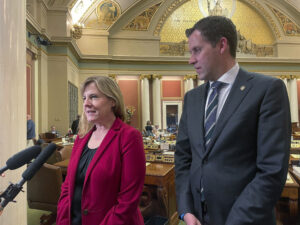Campaign ’08: Giving U.S. Health Care a Checkup
On May 5, the day before Barack Obama all but clinched the Democratic presidential nomination, I visited Harbor-UCLA Medical Center in Torrance, Calif., because I was sick -- sick of stories about the Rev. Jeremiah Wright and his most famous parishioner and of television close-ups of Obama drinking beer and Hillary Clinton belting straight shots in efforts to show their inner blue collars.
On May 5, the day before Barack Obama all but clinched the Democratic presidential nomination, I visited Harbor-UCLA Medical Center in Torrance, Calif., because I was sick — sick of stories about the Rev. Jeremiah Wright and his most famous parishioner and of television close-ups of Obama drinking beer and Hillary Clinton belting straight shots in efforts to show their inner blue collars.
This election should be about the issues, and health care is certain to be a big one. I thought I would begin to check it out at this public hospital, located in the heart of a major blue-collar area.
Harbor-UCLA Medical Center, operated by Los Angeles County and the university’s medical school, serves a large, racially and economically mixed population in a broad coastal plain southwest of downtown Los Angeles known as South Bay. It is a working-class area, more middle class than poor. Politically, South Bay is something of a bellwether. The Reagan Democrats first emerged here, and in the ’90s their discontent foreshadowed their return to the Democratic Party.
At the urgent-care center, which treats the walk-in sick, more than 50 men and women were waiting to see a doctor. They mirrored the population — white, Latino, Asian and African-American. They did not fit the bigoted stereotype of the uninsured illegal immigrants from somewhere south of the border.
Dr. Gail Anderson, the hospital medical director, said the composition of the urgent-care patients was a sign of the growing number of uninsured. “Generally, we’re having people who would normally be covered,” he said, “working-class, mixed-ethnic, not just abject indigent types. Day in and day out, it is a cross section of working groups in the community.”
The uninsured have also strained the hospital’s emergency room, a situation exacerbated by the closing of another major county hospital about 10 miles away.
Dr. Roger Lewis of Harbor-UCLA’s Department of Emergency Medicine recently told a congressional committee of a day in March when “there were 78 patients undergoing treatment in the ED [emergency department]. Because we don’t have room for that number of patients, 33 were being treated in chairs or hallways not originally intended for patient care, 37 patients were still in the waiting room waiting to be seen by a physician, and 20 patients we had previously admitted to the hospital were being ‘boarded’ in the ED because there was no room in the inpatient hospital wards. Some of our admitted patients had been waiting one or two full days for a bed upstairs. Not surprisingly … we had no space for incoming ambulance patients.”
Harbor illustrates a national problem. The National Coalition on Health Care, composed of unions, health organizations, General Electric and others, reported that the uninsured are increasing, with most of them coming from working families. Most are native or naturalized citizens. The number of workers with employer-based health insurance dropped from 70 percent in 1987 to 59 percent in 2006. Nearly 40 percent of the uninsured live in households earning $50,000 or more a year.
The concern over health insurance is reflected in polls. A survey of economic concerns by the Kaiser Family Foundation found that paying for gasoline was first, with 44 percent, followed by getting a good-paying job or a raise, 29 percent, and paying for health care and health insurance, 28 percent.
There are clear differences in health insurance policy between Barack Obama and presumptive Republican nominee John McCain.
McCain has proposed making health insurance portable, from job to job. Americans could shop for insurance, aided by a tax credit of $2,500 for individuals and $5,000 for families. But as Elizabeth Edwards, wife of former Democratic presidential aspirant John Edwards, said, the McCain plan would not assure coverage for people with pre-existing conditions — including her, with breast cancer, or even McCain himself, with melanoma.
Obama’s plan provides for insurance for all, comprehensive benefits and portability. He wouldn’t require everyone to buy insurance, as Hillary Clinton has proposed. But he has advocated government aid to help people buy policies. This program would be financed by eliminating the Bush tax cut for incomes of more than $200,000 and by eventually pulling out of Iraq. McCain supports the Bush tax cut and wants the U.S. to stay in Iraq.
These are the disagreements that should determine the election, not distractions such as the furor over Obama’s pastor. The Wright episode was supposed to have destroyed Obama with white voters. But Obama, who barely lost to Clinton in Indiana, actually improved his showing among white voters in that state from the previous primary in Pennsylvania. An analysis of exit polling data in predominantly white Indiana by Jay Cost of RealClearPolitics showed Obama reducing Clinton’s margin among white women from 35 percent in Pennsylvania to 20 percent in Indiana. Her lead over Obama among white Catholics dropped from 44 percent in Pennsylvania to 22 percent in Indiana, and among union households from 18 percent in Pennsylvania to 4 percent in Indiana.
The trend shows that economic issues such as health care may well be more important than race in the outcome of this election.
Your support matters…Independent journalism is under threat and overshadowed by heavily funded mainstream media.
You can help level the playing field. Become a member.
Your tax-deductible contribution keeps us digging beneath the headlines to give you thought-provoking, investigative reporting and analysis that unearths what's really happening- without compromise.
Give today to support our courageous, independent journalists.






You need to be a supporter to comment.
There are currently no responses to this article.
Be the first to respond.